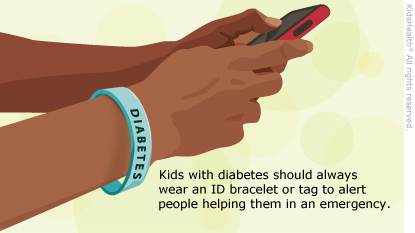Hypoglycemia (low blood sugar) can happen in kids who take insulin or other diabetes medicine. When blood glucose levels fall too low, your child may begin to feel sick and need treatment right away. Some children might not realize their blood glucose is dropping. Testing the blood sugar with a home blood glucose monitor can quickly tell you whether your child's symptoms might be due to hypoglycemia. Treatment will raise blood sugar levels. This is done by giving glucose by mouth or, in severe cases, a glucagon injection.

- Give your child diabetes medicines exactly as directed.
- Your child should not take a bath or hot shower right after an insulin shot — doing so can cause insulin to be absorbed into the bloodstream too quickly.
- Your child should follow the timing of meals and exercise outlined in the diabetes management plan.
- Check your child's blood sugar regularly, including before, during, and after exercise.
- Teach your child the signs of hypoglycemia and when to ask for help.
- Your child should carry sugar at all times in case hypoglycemia happens.
- Be on the lookout for any of these symptoms that could signal low blood sugar:
- shakiness
- moodiness
- fast heartbeat
- pale, sweaty skin
- headache
- extreme hunger
- blurred vision
- lightheadedness
- tiredness
- nightmares
- confusion
- seizures
- unconsciousness
If your child develops hypoglycemia AND is awake and alert enough to safely swallow food or drink:
- Have your child take sugar by mouth. Your child could take glucose tablets or gel, drink 4 ounces of juice or regular soda, or eat 6 jellybeans or hard candies or 2 tablespoons of raisins.
- Wait 15 minutes and recheck your child's blood sugar levels.
- Repeat these steps until blood sugar levels are no longer low. Then give your child a snack that contains carbohydrates and protein to help prevent the blood sugar level from dropping again.
Inject glucagon right away if your child has a seizure, is unconscious, is extremely confused or vomiting, or if symptoms keep getting worse after your child takes sugar by mouth.

When is hypoglycemia likely to happen? Hypoglycemia can happen at any time, but is more likely when a child with diabetes:
- eats less than the expected amount of carbohydrates after taking diabetes medicine
- takes diabetes medicine incorrectly
- exercises more than usual
- is asleep
- drinks alcohol or uses recreational drugs
- is sick and is vomiting or eating less than usual
What are the risks from drinking alcohol or using drugs? Drinking alcohol can be very risky for people with diabetes because it makes it hard for the body to keep blood glucose in a normal range. This can cause a very quick drop in blood glucose in people with diabetes. When a person with diabetes uses drugs or alcohol, they may not be able to sense low blood sugar levels.
Is it safe for my child to drive? It is safe to drive if your teen takes precautions before and during driving. Your teen should:
- Do a blood sugar check and treat hypoglycemia, if needed, before driving.
- Keep some form of sugar in the car to use if symptoms of low blood sugar happen.
- Know to pull over to the side of the road safely right away if feeling symptoms of low blood sugar. Your teen should treat the hypoglycemia quickly, then wait to drive again until the symptoms are gone.




